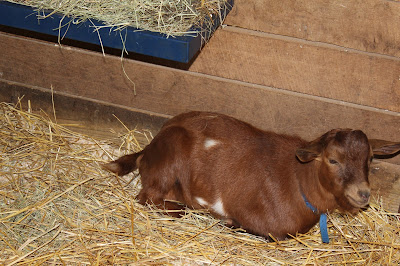Ladies First
Lost Valley's TM Via Dolorosa "Rose"
We just are in love with sweet Rose. But her sweet and easy going personality doesn't stop her from being the head of the other girls.
Born 3/15/16
Sire: Lost Valley ML Toby Mac *S/*B
Dam: ARMCH Hill Country's KW Bridges Burn 2*D/1*M VG
2xJrGCH, 5xGCH, 4xBU, 5xBOB, 1xBIS(Sr)
Lost Valley's NKO Rachel's Well "Rachel"
Rachel definitely has a mind of her own, but can be reasoned with. LOL. She is a great hopeful for us as her momma has recently become a Sr. Grand Champion.
Born 3/9/16
Sire: Lost Valley LG Neeko *S
Dam: MCH/GCH (p) Lost Valley CC Tatiana 4*D/1*M
2012 AGS National Jr Champion2xJrGCH, 2x SrRGCH, 2xSrGCH, 4xBU, 1xBOB
Lost Valley's Sochi's Port "Sochi"
Sochi is the baby of the bunch and she's still trying to find her place in the herd. She would rather sit on our laps then hang out with the other goats and has such a cry that melts your heart.
Born 8/2016
Sire: MCH/CH (p) Creek Bottom Z Harbor Master (4xRGCH, 2xGCH)
Dam: Lost Valley PG Nickita 5*D/4*M
And Now Meet the Boys...
Lost Valley's CC Joseph's Dreams "Joey"
Sweet Joey, we used to say we should have called him lover boy. He still is a lover boy even though he's grown into his "manhood"!
Born 3/10/16
Sire: Lost Valley KW Casting Crowns +*S/+*B
Dam: ARMCH Lost Valley TB Obie 3*D/*M
2xJrGCH, 5xGCH, 5xBU, 1xBOB, 3rd place 08 Nationals
Lost Valley's TM Jericho's Wall "Jerry"
Jerry is the head of the herd, yet he's easy to work with and has a great personality.
Born 3/5/16
Sire: Lost Valley ML Toby Mac *S
Dam: ARMCH Hill Country KW Bridges Burn 2*D/1*M VG
2xJrGCH, 5xGCH, 4xBU, 5xBOB, 1xBlS(Sr)
2009 AGS National Champion Sr. Doe
| Lost Valley's Mai Best Chance "Chance" |
Chance is our easy-going guy and is so very lovable.
Born Spring 2016
Sire: Lost Valley LG Neeko *S
1xGCH
Dam: ARMCH/GCH Lost Valley Z Mai Tai 4*D/3*M
1xJrGCH, 2xRGCH Sr, 4xGCH Sr, 2xBOB, 2xBIS, 2xBU































